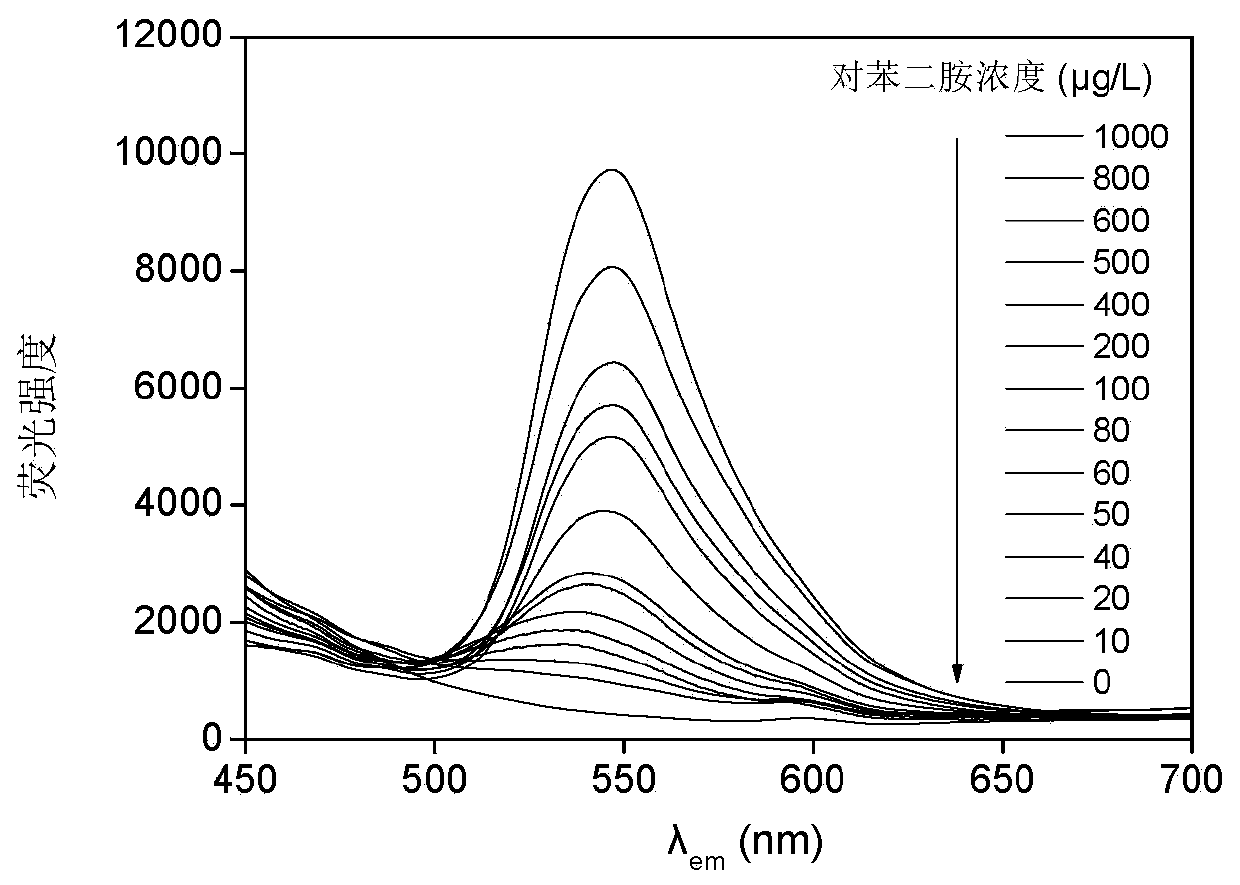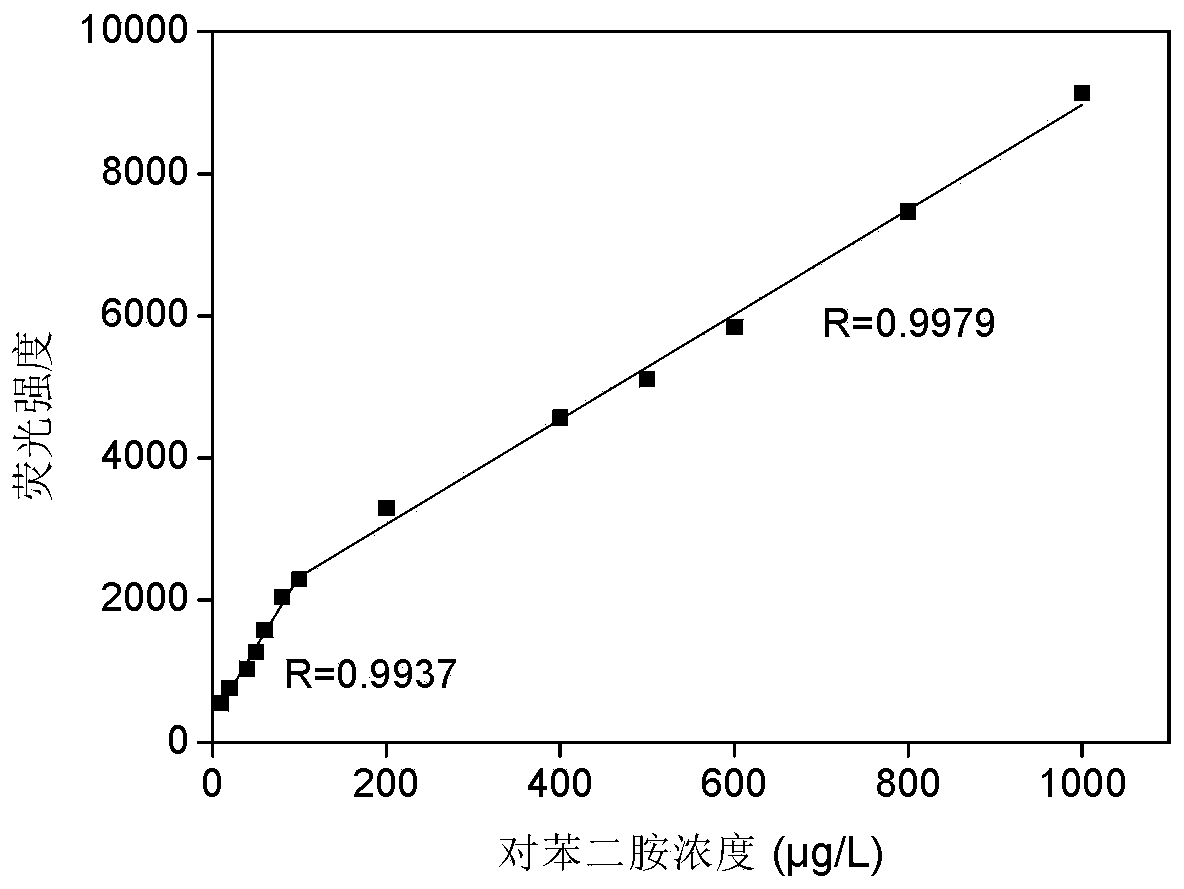Method for rapidly and efficiently detecting trace p-phenylenediamine
A high-efficiency technology for p-phenylenediamine, applied in the field of analysis and detection of p-phenylenediamine, can solve the problems of unobtainable, enhanced aggregation fluorescence, high detection limit, etc., and achieve the effects of less sample consumption, high optical transparency and high sensitivity
- Summary
- Abstract
- Description
- Claims
- Application Information
AI Technical Summary
Problems solved by technology
Method used
Image
Examples
Embodiment 1
[0038] Example 1 Effect of P-Phenylenediamine Concentration on Fluorescence Intensity of Solid Phase Fluorescence Detection Membrane
[0039] A detection method for p-phenylenediamine is characterized in that it comprises the following steps:
[0040] Step 1: dissolving cotton cellulose to prepare a cellulose solution with a mass concentration of 5%;
[0041] Step 2: after degassing the cellulose solution prepared in step 1, casting the film on the substrate, washing after solidification to obtain a regenerated cellulose gel film;
[0042] Step 3: put the regenerated cellulose gel film obtained in step 2 into 1 g / L sodium periodate aqueous solution and oxidize it at room temperature for 6 hours to obtain a dialdehyde cellulose gel film;
[0043]Step 4: the dialdehyde fiber membrane obtained in (3) is placed in different concentrations of p-phenylenediamine solutions (0, 10, 20, 40, 50, 60, 80, 100, 200, 400, 500, 600, 800 , 1000 μg / L) to react to obtain a cellulose film enri...
Embodiment 2
[0046] Example 2 Effect of Salicylaldehyde Concentration on Fluorescent Intensity of Solid-Phase Fluorescence Detection Membrane
[0047] The concentration of p-phenylenediamine solution was fixed at 250 μg / L, and the effect of salicylaldehyde concentration on the fluorescence intensity of solid-phase fluorescence detection membrane was studied. Specific operation: Put dialdehyde cellulose membranes of the same size into 6 groups of 250 μg / L p-phenylenediamine solutions respectively, react in a water bath at 25°C for 1 hour, take them out and wash them. Then put the film in the concentration of 0%, 0.01%, 0.05%, 0.1%, 0.5%, 1% salicylaldehyde solution to react for 10min, wash with water, and dry in an oven at 50°C, and then test the excitation of each system at 370nm Fluorescence spectra at wavelengths. The results showed that as the concentration of salicylaldehyde increased, the fluorescence intensity of the solid-phase fluorescence detection membrane first increased and th...
Embodiment 3
[0048] Example 3 The influence of the concentration of aldehyde groups in the oxide film on the fluorescence intensity of the solid-phase fluorescence detection film
[0049] Dialdehyde cellulose films with different aldehyde content (0, 50, 100, 200, 300, 400 μmol / g) were obtained by changing the concentration of sodium periodate solution and oxidation time. Afterwards, the obtained dialdehyde cellulose membranes were respectively placed in 6 groups of p-phenylenediamine solutions with a concentration of 250 μg / L, reacted in a water bath at 25° C. for 1 hour, and then removed and washed. Then, the p-phenylenediamine-enriched film was reacted in 0.5% salicylaldehyde solution for 10 minutes, washed with water, and dried in an oven at 50°C, and then the fluorescence spectrum of each system at an excitation wavelength of 370nm was tested. The results showed that the higher the aldehyde group content of dialdehyde cellulose, the greater the fluorescence intensity of the solid-phas...
PUM
| Property | Measurement | Unit |
|---|---|---|
| Maximum emission wavelength | aaaaa | aaaaa |
Abstract
Description
Claims
Application Information
 Login to View More
Login to View More - R&D
- Intellectual Property
- Life Sciences
- Materials
- Tech Scout
- Unparalleled Data Quality
- Higher Quality Content
- 60% Fewer Hallucinations
Browse by: Latest US Patents, China's latest patents, Technical Efficacy Thesaurus, Application Domain, Technology Topic, Popular Technical Reports.
© 2025 PatSnap. All rights reserved.Legal|Privacy policy|Modern Slavery Act Transparency Statement|Sitemap|About US| Contact US: help@patsnap.com



